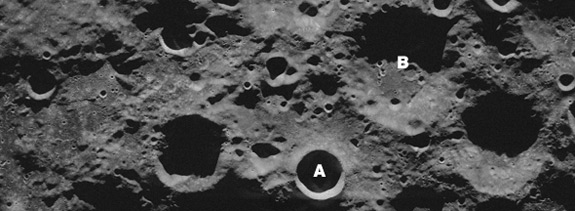Leave the skates on Earth -- Cornell researchers find no evidence of ice reserves on the moon
By Lauren Gold

Alas, the moon is not for winter sports. Never mind the difficulty of a triple axel in a bulky spacesuit (though the diminished gravity might help) -- ice, it turns out, is hard to come by up there.
That's the latest word from astronomers at Cornell and the Smithsonian Institution, who used high-resolution radar-mapping techniques to look for ice deposits at the lunar poles. Their research appears in the Oct. 19 issue of the journal Nature.

The researchers, led by Donald Campbell, professor of astronomy at Cornell, analyzed radar transmitted to the moon from the Arecibo Observatory in Puerto Rico and received 2.5 seconds later at the Robert C. Byrd Green Bank Telescope in West Virginia. Using 20-meter resolution, 13-centimeter wavelength radar, they looked at areas around the lunar south pole where earlier low-resolution images had indicated a high circular polarization ratio (CPR) -- a possible signature of low-temperature water ice.
They found similar high CPR values. But they also found that those values are not confined to areas that stay cold enough to sustain ice; they occurred in sunlit areas as well, where temperatures can reach 243 degrees Fahrenheit (117 degrees Celsius) and ice would evaporate rapidly. That indicates that scattered rocks associated with young impact craters are more likely the causes of the high CPR.
Accessible ice would be a valuable resource for any long-term human presence on the moon, but reserves could only exist in deep, permanently shaded craters at the poles, where the temperature doesn't rise above about -280 F (-173 C), Campbell said.
Previous data had given the search for lunar ice a boost, including 1992 radar data indicating ice deep in craters at the poles of Mercury, 1996 radio data from the moon taken by the Clementine orbiter and the Lunar Prospector Orbiter's 1998 discovery of an elevated amount of hydrogen at the lunar poles.
But the elevated hydrogen level could come from other sources -- solar wind, perhaps -- and subsequent radar data has failed to show any evidence of ice deposits.
Campbell says the new data should close the door on the debate.
"This is much higher resolution than we've ever done before," said Campbell. "We put the nail in the coffin in terms of the fact that these high CPRs are correlated with presence of rocky, blocky material around young impact craters. The assumption of many people is that high CPRs must indicate the presence of water ice. What we're saying is, that might not be the case.
"There is always the possibility that concentrated deposits exist in a few of the shadowed locations not visible to radars on Earth," he added. "But any current planning for landers or bases at the lunar poles should not count on this."
The Arecibo Observatory is operated by the National Astronomy and Ionosphere Center at Cornell for the National Science Foundation (NSF). The Green Bank Telescope is part of the National Radio Astronomy Observatory, which is operated by Associated Universities for the NSF.
Media Contact
Get Cornell news delivered right to your inbox.
Subscribe